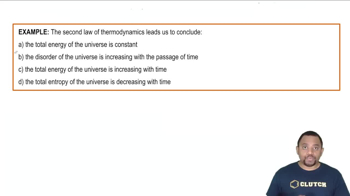Here are the essential concepts you must grasp in order to answer the question correctly.
Entropy
Entropy is a measure of the disorder or randomness in a system. In thermodynamics, it quantifies the number of microscopic configurations that correspond to a thermodynamic system's macroscopic state. A higher entropy indicates a greater degree of disorder, while a lower entropy suggests more order. Understanding how entropy changes during processes is crucial for predicting the spontaneity and direction of chemical reactions.
Recommended video:
Entropy in Thermodynamics
Second Law of Thermodynamics
The Second Law of Thermodynamics states that the total entropy of an isolated system can never decrease over time. It implies that natural processes tend to move towards a state of maximum disorder or entropy. This law is fundamental in determining whether a process is spontaneous; if the entropy of the universe increases, the process is likely to occur. This principle is essential for analyzing changes in entropy during chemical reactions or physical transformations.
Recommended video:
Second Law of Thermodynamics Example
Gibbs Free Energy
Gibbs Free Energy (G) is a thermodynamic potential that measures the maximum reversible work obtainable from a system at constant temperature and pressure. It combines the system's enthalpy and entropy to determine spontaneity; a negative change in Gibbs Free Energy (ΔG < 0) indicates a spontaneous process. Understanding Gibbs Free Energy is crucial for analyzing how entropy changes in various processes, as it directly relates to the balance between enthalpy and entropy.
Recommended video:
Gibbs Free Energy of Reactions
 Verified step by step guidance
Verified step by step guidance


